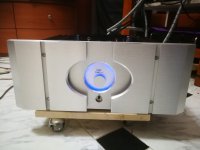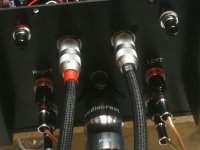while still in that phase
put some thermal grease between bridges and base plate
do not forget split washers , under bridge nuts
put some thermal grease between bridges and base plate
do not forget split washers , under bridge nuts
All part of the plan. But those caps are actually oriented to make a good explosion, aren’t they?
It’s not that many have been sent, it’s that I’m only sending them to people I know will build them, and fairly quickly.
(Which is wayyyyy better than I’ve managed… I’ve been so busy with real life I can’t see straight lately… no worries, things will calm down in another month I think.)
I have found my boards! When I opened my parts box to stuff them, somehow I had put a similar sized J2 clone board in that box. Rifling through my J2 clone boxes, I found the AlephJ boards. Let the stuffing begin. This will be in my F5 amp, so it will only be a board transplant.
Russellc
Gonna beat me by a mile. Care to share some stuffing pics and lessons learned along the building?
Regards,
Andy
Regards,
Andy
That’s Towelie. No, but seriously, can you guess that towels main purpose/normal purpose?
My guess you are using them like I do for amp/firearm/ammunition assembly....to catch small parts so they dont bounce all over my hardwood floors when dropped?
Or clean youself up if you reach ground potential?
Russellc
Gonna beat me by a mile. Care to share some stuffing pics and lessons learned along the building?
Regards,
Andy
Will do, not stuffed yet. Nothing much to learn here, just following the BOM
with a sub or two, depending on what mouser got back in stock. I wanted to duplicate 6l6's BOM to the letter. Not ultra critical, but following a working amps build guide precisely will make problem solving much easier if required.
F5 box has dual 300VA 18/18 Antek, with discrete (all 16, a pain) rectification, and dual Peter Daniels PS boards with no longer available Panasonic Caps.
I can reuse a couple holes I've already drilled and tapped for the F5, but a couple more will be needed. I think this board (unlike the Peter Daniels F5 board) will be too heavy to mount dead bug style off the mounted mosfets.
That worked on the F5, board has no caps, few tiny semis and resistors, smaller than a business card, ultra light weight. It hung off the two mosfets just fine.
Russellc
This is my realization Aleph J, I want to thank all those who have given me useful advice and with that wonderful step by step guide I have not made any serious mistakes.
The sound is very crystalline and airy mid and high range identical to the big brother X150.5 (wonderful realization by Mr. PASS), obviously it does not have the Punch of the X150.5 but I am happy with its sound. I attach some photos of my little creature ... 😀
The sound is very crystalline and airy mid and high range identical to the big brother X150.5 (wonderful realization by Mr. PASS), obviously it does not have the Punch of the X150.5 but I am happy with its sound. I attach some photos of my little creature ... 😀
Attachments
My guess you are using them like I do for amp/firearm/ammunition assembly....to catch small parts so they dont bounce all over my hardwood floors when dropped?
Or clean youself up if you reach ground potential?
Russellc
Haha! You’re pretty close. It is a big baby wipe type towel. Used as amp assembly table protection whilst i wait for kid number three to arrive any day

Last edited:
Will do, not stuffed yet. Nothing much to learn here, just following the BOM
with a sub or two, depending on what mouser got back in stock. I wanted to duplicate 6l6's BOM to the letter. Not ultra critical, but following a working amps build guide precisely will make problem solving much easier if required.
F5 box has dual 300VA 18/18 Antek, with discrete (all 16, a pain) rectification, and dual Peter Daniels PS boards with no longer available Panasonic Caps.
I can reuse a couple holes I've already drilled and tapped for the F5, but a couple more will be needed. I think this board (unlike the Peter Daniels F5 board) will be too heavy to mount dead bug style off the mounted mosfets.
That worked on the F5, board has no caps, few tiny semis and resistors, smaller than a business card, ultra light weight. It hung off the two mosfets just fine.
Russellc
I am doing the same, but had to make a couple of subs, though only on a couple resistors and caps. Not sure I will sub the caps, I’ll see how it looks when the shipment comes and take it from there.
Will you be using C1?
Given the complexity of the PSU, I’ll make the rest according to makers wishes

This is my realization Aleph J, I want to thank all those who have given me useful advice and with that wonderful step by step guide I have not made any serious mistakes.
The sound is very crystalline and airy mid and high range identical to the big brother X150.5 (wonderful realization by Mr. PASS), obviously it does not have the Punch of the X150.5 but I am happy with its sound. I attach some photos of my little creature ... 😀
Makes my stuff look stone age rudimentary. Nice, fuuuuugly work!
Really impressive those 100mF caps, Andy! and 2X300VA donuts! 😱

Thanks! Decided to try something approaching Nelsons «Porn big» caps to power my J Zen / Babelfish J aka «BJ», hoping it will blow my mind. Pretty decent specs too. The biguns have a very low ESR, and it also stays low at higher freqs. With decoupling film MKP’s at the rails, I am hoping for both oomph and clarity/air. We’ll see. With this P2P it is easy to test with and without, just a few screws away.
But, I do think it’s a good idea to post some more pics after wiring it up, so as to minimize risk of imminent blow-up.

Last edited:
Haha! You’re pretty close. It is a big baby wipe type towel. Used as amp assembly table protection whilst i wait for kid number three to arrive any day
#3, woah!
(So you‘re kinda building amps in parallel, aren’t you? :devil: )
((That was rude, preemptive apologies))
Makes my stuff look stone age rudimentary. Nice, fuuuuugly work!
With the money I spent to make it, I bought Mr. Nelson's original Aleph J. 😕
Hi @joaoranito!
I think I had similar problem to yours and struggled with it for quite long time. You can read description of my troubles here - Post #6376 and in my previous posts, if you want.
Finally I found the LSJ74 Jfets were at fault. Even when desoldered and checked they still looked fine! (post 6468). But the problems did dissapear when I changed them with original Toshibas! I tried the Toshibas just for the short test though. Just made the THD measurements and made sure there is no hum in the output, then I put these Toshibas into J Zen variant that I was building already.
So, I could prove to myself that Jfets were at fault, but I did not understand why, and most importantly, I still cannot be sure that the new Jfets would not be damaged in my PCBs if used longer again (as LSJ74 were also fine in the beginning). I am waiting for some more Toshibas from diyAudio store now and eventually will try to put them into these Aleph J boards to find out.
I am not an expert as you can see. So take it only as a story from the wild. Perhaps your problem is different. I dunno!
-Alvis
Thank you so much for the info, I should have read all the thread before posting. It looks like the JFETs are where I should start. They were bought in diystore but sometimes things fail, even when bought in diystore 😉 I'll order some new pairs and give it a try.
Meanwhile, I will measure voltages and compare both boards (and hopefully also THD), it looks like there are some discrepancies. For instance, when biased to almost the same voltage (409mV,411mV), the noisy channel shows a bigger difference between voltage across R16 and R17 than the good channel: R17=441mV, R16=376mV (noisy) vs R17=419mV, R16=397mV (good). If that's relevant, I don't know... 🙂
Anyway, it looks like whatever degraded is still degrading: a couple of days ago I was able to get the offset near to zero or even negative (although it fluctuated and then drifted up) but today it doesn't go below 20mV (and then rises to around 50mV, always fluctuating rapidly), even with the trim pot clicking in the end, so no more adjustment possible.
I got a bit worried by the comment to your original post, regarding static electricity issues with the JFETs. I never used a grounding wrist band on any build (including JFETS and MOSFETs) and never had a problem. But that could really be the issue, next time I'll be (even) more careful.
Again, thank you a lot!
I'll keep measuring things until I get the JFETs and keep listening to the Aleph J. Even with those problems I really like it, more than expected. In fact, it replaced my Audion Sterling Plus in the "small" system, with a pair of Markaudio 11MS drivers on a Ibelin reflex box (also DIY). Sound is very good indeed, can't wait to get everything ok to try it out with my Martin Logans. I think there is a the risk of a good match... 😉
I'll post back when there are developments, time has been a bit short and measuring stuff requires some peace of mind... 🙂
Why don’t you order new Toshibas from the store? Sources whisper the new Toshibas in the store are from Papas personal stash. Which means, they are matched by him. And there might not be another opportunity. So put quad 6-8 mA’s in your basket, pay cash or credit, and be happy. If they are not at fault in your particular circuit, nevermind: quad Papa-matched J74’s will never go out of DIY fashion 🙂
Something about the store LSJ’s IDSS having IDSS right around bias current just makes me a bit uneasy…
Will do ASAP, just trying to figure out if I have (by chance!) a matched pair, at least, lying around, I rememeber I bought a few quads of JFETs. Or were they LSK170? I'll find out...
Thanks!
Why don’t you order new Toshibas from the store? Sources whisper the new Toshibas in the store are from Papas personal stash. Which means, they are matched by him. And there might not be another opportunity. So put quad 6-8 mA’s in your basket, pay cash or credit, and be happy. If they are not at fault in your particular circuit, nevermind: quad Papa-matched J74’s will never go out of DIY fashion 🙂
Something about the store LSJ’s IDSS having IDSS right around bias current just makes me a bit uneasy…
Well, I found out two matched pairs of J74s from diystore in my drawers 🙂
I'll give them a try asap and report back!
Meanwhile, I will measure voltages and compare both boards (and hopefully also THD), it looks like there are some discrepancies. For instance, when biased to almost the same voltage (409mV,411mV), the noisy channel shows a bigger difference between voltage across R16 and R17 than the good channel: R17=441mV, R16=376mV (noisy) vs R17=419mV, R16=397mV (good). If that's relevant, I don't know... 🙂
These voltages on R16 and R17 are ok, I do not think they indicate any problem. Mosfets from the diyAudio store are matched well but not perfectly (I know because I measured them myself and then changed to the better matched new ones that I matched myself from the tube of 25 from Mouser). Also, the power resistors themselves are not perfectly the same (I also did changed them to the specially matched ones 🙂 and this made the differences of the voltages on the source resistors much smaller - but neither of that solved the problem in my case - only Jfets 🙁)
- Home
- Amplifiers
- Pass Labs
- Aleph J illustrated build guide





